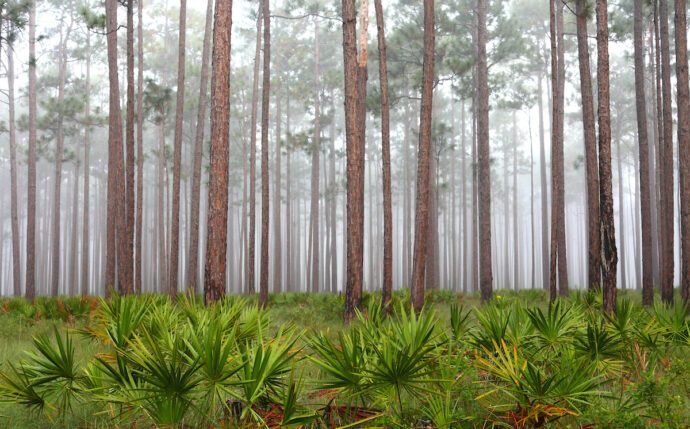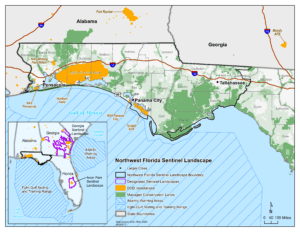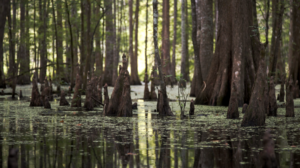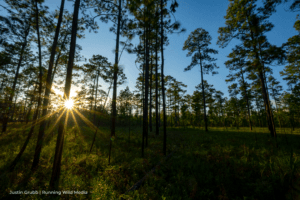
Moving from visioning to action: Insights from the first year of the Northwest Florida Sentinel Landscape.
Kent Wimmer, Coordinator of Northwest Florida Sentinel Landscape, and Senior Northwest Florida Representative, Defenders of WildlifeThis is the second of two articles that seek to capture insights and lessons learned from the emergence of the Northwest Florida Sentinel Landscape (NWFSL). The first article, published in November 2022, highlighted the key factors and successes that allowed agencies and non-governmental organizations to come together to build a broad coalition of partners—and sustain that coalition through the onset of the pandemic—to successfully realize the designation of this new Sentinel Landscape. This second article highlights how the partnership has moved forward post-designation, underscoring how consistent leadership and support is aiding collaboration to achieve landscape conservation goals and how our partnership is adapting to evolving needs of its partners to be a more effective.

The Northwest Florida Sentinel Landscape was designated in early 2022. Map courtesy of Defenders of Wildlife on behalf of the partners of the Northwest Florida Sentinel Landscape.
In February 2022, the Sentinel Landscapes Federal Coordinating Committee designated Northwest Florida as one of now twelve Sentinel Landscapes in America. Sentinel Landscapes bring together partners to work towards more significant conservation results through collaboration than can be achieved by independently pursuing actions and projects. The Northwest Florida Sentinel Landscape has grown into a partnership of over four dozen federal and state agencies, non-governmental organizations, regional coalitions and private landowners. Our partnership is working to retain working lands, conserve wildlife habitat and protect military testing and training missions in Northwest Florida. We are doing this by implementing conservation and restoration projects that bolster mission resilience, and by providing sustainable social, environmental and economic benefits to our partners and stakeholders.
The Sentinel Landscape designation has created a nexus for collaboration, and accelerated conservation and stewardship activities in the region. Since the beginning of federal FY22, our partners provided nearly $66 million dollars to conserve and maintain compatible land uses on over 26,000 acres in the NWFSL. Our partners worked with private landowners to develop forest management plans for nearly 37,000 acres to protect wildlife habitat, maintain forest lands and protect military missions. Recent successful landscape-scale collaborative projects in Northwest Florida include:
- On August 2 at Eglin Air Force Base, the US Air Force hosted a ceremony/celebration of the delisting of the Okaloosa darter from the Endangered Species List. USDOI Assistant Secretary for Fish and Wildlife and Parks Shannon Estenoz and senior staff with the USFWS and USAF participated.
- On June 30, the Florida Department of Environmental Protection (FDEP) acquired 12,439-acre Telogia Creek Florida Forever project for $18,098,745. This fee simple acquisition will be managed by the Florida Fish and Wildlife Conservation Commission as a new public wildlife management area. This area is under a military operations flyway and is a key landscape linkage between the Apalachicola National Forest and the upper Apalachicola River.
- Since October 1, 2021, the Navy, Santa Rosa County, the State of Florida, the Trust for Public Land and a private foundation have partnered through a series of acquisitions to protect 6,386 acres of land around Naval Air Station Whiting Field, preventing encroachment and ensuring training flight paths are protected from incompatible development. Over the past dozen years, these partners have conserved over 14,000 acres to buffer NAS Whiting Field.
- Conserving the Apalachicola River corridor and its biodiversity is the top priority for the Florida Forever program. This nearly 49,000-acre acquisition area would conserve nearly all of the remaining unprotected land in the river’s corridor including its bluffs and steephead ravines. In 2021, FDEP was awarded a $31 million grant from the National Fish and Wildlife Foundation’s Gulf Environmental Benefit Fund to acquire in fee approximately 32,000 acres within this project; funding from the Florida Forever program will be used for the remainder. FDEP is currently negotiating purchase of these lands through a combination of fee-simple and conservation easements.

In 2020, a $43 million acquisition of the nearly 17,000-acre Bluffs of St. Teresa tract was funded through a state and federal partnership. Over $38.5 million of Florida Forever funds combined with over $4.4 million of federal funding from the US Air Force’s REPI Program made this acquisition possible. The US Air Force’s contribution preserved the military operations air space over the tract which is being managed as a state forest and state park.
As we reflect back on the collaboration that brought these outcomes forward, what are the key aspects that have allowed us to be successful? The following captures observations and insights as our partnership has transitioned from its efforts to organize and secure designation into the process of leveraging the power of the partnership to accelerate conservation and stewardship outcomes within the landscape:
The value of consistent coordination leadership and communications
We have benefited from the privilege of having a full-time coordinator and a part-time consultant funded by our federal partners. This core staffing has allowed us to enhance coordination among our stakeholders and partners to help them achieve their priorities. With this capacity, we have been able to help partners better understand where priorities overlap, and track the status of projects being pursued by numerous entities—all of which has been instrumental in creating a more cohesive and effective landscape partnership and a conservation delivery network.
Through our ability to articulate a collective vision for the NWFSL, our partners can see how their organizations’ efforts fit into and complement regional priorities for conserving habitats, retaining working lands, and protecting military missions. Defenders of Wildlife, as host organization for the NWFSL, has been instrumental in providing communications and networking support here as well. To encourage sharing of information and consistent communication amongst partners, Defenders of Wildlife hosts virtual collaboration calls for all our partners and supporters in the even-numbered months, and we distribute a monthly newsletter highlighting our partners’ successes, funding opportunities, news, resources and the collaboration among partners.
We are seeing the importance of coordination capacity and communications ever more clearly through the two work groups that we have formed as our conservation delivery networks. These work groups meet virtually in the odd-numbered months:
- David Wolfe, a part-time consultant, coordinates our Private Lands and Natural Systems Stewardship work group which is focused on connecting partners and supporting communication and collaboration to conserve and restore habitat, retain working agriculture and forest lands, and protect water quality and quantity to help maintain the evolving missions of the region’s military installations.
- Our Climate Resiliency Work Group is accelerating nature-based solutions that mitigate coastal risks and contribute to the climate resiliency of military installations and the landscapes that overlap mission footprints. In the coming year, we will bring aboard another person to coordinate our partners’ Climate Resiliency efforts—this added coordination capacity will accelerate efforts here at a critical moment.
Be adaptable to the evolving needs of your partnership
Over the last two years, with the extraordinary levels of public funding that is becoming available for environmental restoration and climate resiliency, we have found that our partners are struggling to find the capacity to develop and prepare proposals, manage and implement projects, and take advantage of this federal and state largesse. Our partnership offers a vehicle for partners to work together to respond to these opportunities more effectively. In 2022, our partners were unsuccessful on five proposals to NFWF and USDA seeking $6.6 million. We have responded as a partnership by following up with NFWF and USDA to gain greater insight about grant program priorities and how to make proposals more competitive. This has allowed us to work with our partners to seek out eligible applicants to better understand their priorities, to refine mutual interests, and collaborate to develop proposals.
Leveraging our coordination staffing and communication networks in this way to work with and encourage our partners to identify and develop collaborative proposals will yield proposals that are more competitive and successful in securing funding. More importantly, by seeking to create large-scale, multiple agency/partner coordinated projects and programs rather than many small-scale projects, the proposals—when funded—will produce greater impact on the ground. Recognizing the need that exists within our landscape in this areas, we intend to dedicate additional staff support to identify opportunities for collaborative climate resilience and adaptation projects. This support will focus on soliciting proposal concepts, convening and supporting partnerships for proposals, and coordinating and supporting the development and submission of collaborative proposals for near-term resilience and climate adaptation projects.
With our help, our partners collaborated on and submitted four pre-proposals to NFWF’s America the Beautiful Challenge program, and a pre-proposal submitted to NFWF’s National Coastal Resilience Fund program in April. Only state agencies are eligible to apply for higher funded categories of the America the Beautiful Challenge program. While we were successful in having only one our state agency partners submit any pre-proposals to these higher funded categories, we made great progress in gaining a deeper understanding about the state agencies’ priorities and capacity limitations. These learnings will guide us as we develop collaborative proposals that we hope the state agencies will submit in 2024.
Tend to the relationships that are the currency of collaboration
As I described in the first article, the NWFSL Partnership was established through virtual meetings during COVID. Since designation as a Sentinel Landscape in February 2022, our interactions as a partnership have been virtual monthly meetings, updates via emails and newsletters, and coordinators giving presentations and participating in partner meetings. To enhance the efficiency of our meetings, we have adjusted by combining two work groups that have overlapping members and shifted to meeting every other month virtually. As valuable as it is to have virtual spaces for consistent interaction and communication, we felt something was missing.
To build camaraderie and encourage networking, , we hosted the first NWFSL Partnership in-person meeting on July 20 and 21. We had over 30 participate in the site visit to Eglin Air Force Base on the afternoon of the 20th where we heard presentations about Eglin’s management of several listed species (Okaloosa darter, red cockaded woodpecker, gopher tortoise) and the Air Forces’ largest outdoor recreation program. We also enjoyed a presentation on habitat restoration for the reticulated flatwood salamander at Escribano Point WMA, and land conservation buffering Naval Air Station Whiting Field. Later that evening, over 25 partners enjoyed a social gathering.
On the morning of the 21st, more than 40 partners participated in our NWFSL Partnership meeting. Building off the relationship-building of the site visit and the social event the previous evening, the meeting facilitated productive discussion as we continue to come together to explore our shared vision and the collective opportunities that we have before us. Partners indicated the meeting was highly beneficial, and stated they wished to continue to have an annual in-person partnership meetings with a site visit incorporated and virtual partnership meetings every other month. It is clear that the connections and unstructured time of being in person and sharing physical space with one another allows for energy, new ideas, and momentum to build.

The sun sets through a longleaf pine stand in Northwest Florida. Photo by Justin Grubb, Running Wild Media.
As we reflect back on the first year following the formal designation of the Northwest Sentinel Landscape, it is exciting to see the energy and momentum that built through the lengthy designation campaign translated into accelerated impact on the ground. Like other new partnerships, we are adapting and figuring out what works best, and know this will be a continual process of adaptation and iteration. In the coming year we will engage in a collaborative planning process with the assistance from the LegacyWorks Group to strength our partnership. We also intend to provide our partners with additional capacity to generate resiliency funding proposals through hiring a Climate Resilience Coordinator for the NWFSL.
In recognition of all that we have gained in learning from the experiences of others, we are pleased to share our observations and insights here. Indeed, as we look back we recognize that we are fortunate to have what can be thought of as foundational building blocks for collaborative landscape conservation and stewardship:
- engaged partners with shared goals that have long histories of collaborating on successful projects,
- dedicated and sustained staff coordination and leadership for our partnership, and
- resources to implement collaborative projects.
The NWFSL Partnership looks forward to further success maintaining working lands and conserving wildlife habitat while protecting the missions of the Air Force and Navy installations in Northwest Florida.
For more information on the Northwest Florida Sentinel Landscape, visit our webpage, or contact Kent Wimmer or David Wolfe. For more information on the Sentinel Landscape program, visit the program’s website or watch this video. Founded in 1947, Defenders of Wildlife is a national non-profit conservation organization focused solely on wildlife and habitat conservation and the safeguarding of biodiversity. For more information, please visit Defenders’ website. Photo credit of featured photo at the top of the article: Longleaf pine and palmetto forest in the Apalachicola National Forest; Photo by Julie Tew courtesy of Defenders of Wildlife.
